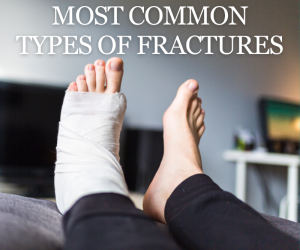 The human skeleton is an extremely intricate system comprising approximately 206 bones and over 100 muscles!!! That is why it is critical to take care of your skeleton, which includes being proactive and lowering your chance of suffering from common types of fractures. We’re going to look at the most frequent types of fractures in further detail.
The human skeleton is an extremely intricate system comprising approximately 206 bones and over 100 muscles!!! That is why it is critical to take care of your skeleton, which includes being proactive and lowering your chance of suffering from common types of fractures. We’re going to look at the most frequent types of fractures in further detail.
What is a Fracture?
Fractures are fractures of the bone. They can be produced by a direct hit or by a weakening bone due to disease, aging, or osteoporosis. While it may appear that a broken bone is a simple injury to recover from, this is not always the case. Fractures vary significantly in terms of kind and degree of the break. This page discusses the most prevalent types of fractures.
A fracture is a break in the bone, either partial or complete. When a fracture occurs, it is characterized as an open or closed fracture:
- An open fracture (also known as a compound fracture) occurs when the bone pokes through the skin and is visible, or when a deep wound exposes the bone through the skin.
- Closed Fracture (also called simple fracture). The bone has been broken, but the skin is still intact.
Types of fractures and their causes
- Greenstick. This is a partial fracture. A section of the bone has been broken, causing the opposite side to bend.
- A greenstick fracture is an incomplete break of a bone that occurs in children because their bones haven’t fully hardened yet.
- Transverse. The fracture runs straight across the bone.
- It’s often caused by twisting, falling or a direct blow to the bone.
- Spiral. The fracture spirals around the bone, which is common in twisting injuries.
- This is typically caused by twisting forces, such as those involved in skiing and football.
- Oblique. The fracture runs diagonally across the bone.
- They are typically caused when you land on your bone at an angle following a fall or when your bone is struck abruptly at an angle (like in a car accident)
- Compression. The bone has been crushed. As a result, the broken bone appears wider or flatter.
- This fracture can occur in the spine and may be caused by osteoporosis or trauma from an injury.
- Comminuted. The bone has fractured into three or more pieces, with fragments present at the fracture site.
- Car accidents and falls from a considerable height, such as from a ladder or roof, are two of the most common causes. Any force applied to your bones may result in a comminuted fracture.
- Segmental. Because the same bone is fractured in two places, a “floating” piece of bone exists.
- Car accidents and falls from considerable heights, such as from a ladder or roof, are two of the most common causes. A segmental fracture can occur as a result of any impact to your bones.
Treatment for fractures
The type of treatment depends on the location and severity of the fracture as well as other factors, such as your age, medical history and overall health. Treatment can include surgical or nonsurgical options.
Nonsurgical treatment for fractures can include:
- Immobilization with a cast or boot
- Medication for pain relief
- Physical therapy after healing
Surgical treatment for fractures may include:
Internal fixation with screws and plates: Metal plates are attached to the outer surface of the bone with small screws through tiny incisions in the skin.
Identifying a fracture
The signs and symptoms of a fracture vary depending on the cause, location, and type of fracture you have. Common signs and symptoms include:
- Pain, which can range from mild to severe
- Swelling
- Bruising
- Redness
- Tenderness
- Deformity in the affected area — a limb may look crooked or shortened compared with the opposite side
To wrap things up!
Hopefully, this page has provided you with a general understanding of the types of fractures you may encounter in the future if you do sustain one. Remember to seek medical attention if you believe you’ve experienced a fracture, as they can provide the finest medical guidance in such cases. For more information contact Dynamic Foot and Ankle Center today!
